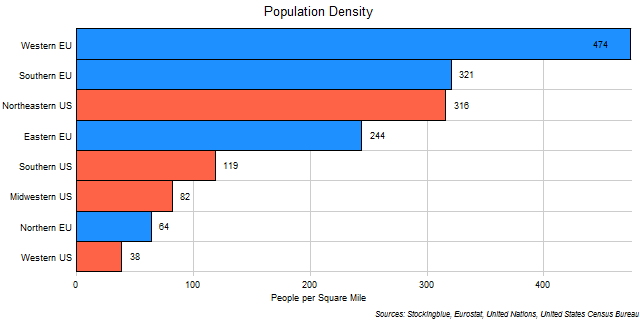
The chart above shows the population density of EU and US regions. The European Union is far more densely populated than the United States having the two most densely populated regions while the United States has three of the four least densely populated regions.
Findings
- The difference between the most densely populated region, the Western EU, and the least, the Western US, is 436 people per square mile (168 people per square kilometer).
- The Western EU is 12 times more densely populated than the Western US.
- The Western EU is 1.48 times more densely populated than the Southern EU which is 1.01 times more densely populated than the Northeastern US which is 1.29 times more densely populated than the Eastern EU which is 2.06 times more densely populated than the Southern US which is 1.45 times more densely populated than the Midwestern US which is 1.28 times more densely populated than the Northern EU which is 1.66 times more densely populated than the Western US.
- The sum of the Southern EU and the Northeastern US's population densities surpasses the Western EU's population density.
Caveats
- EU area data is from 2007; US area data is from 2010.
- EU population data is from 2011; US population data is from 2010.
- The area includes both land and water area.
- Population and area data are from different sources.
- EU and US data are from different sources.
- The Western EU consists of Germany, United Kingdom, France, Netherlands, Belgium, Austria, Ireland, and Luxembourg.
- The Southern EU consists of Italy, Spain, Portugal, Greece, Cyprus, and Malta.
- The Northeastern US consists of New York, Pennsylvania, New Jersey, Massachusetts, Maryland, Connecticut, New Hampshire, Delaware, Maine, Rhode Island, and Vermont.
- The Eastern EU consists of Poland, Czech Republic, Romania, Hungary, Slovakia, Bulgaria, Croatia, Slovenia, Lithuania, Latvia, and Estonia.
- The Southern US consists of Texas, Florida, Georgia, North Carolina, Virginia, Tennessee, Louisiana, South Carolina, Alabama, Kentucky, Oklahoma, Arkansas, Mississippi, and West Virginia.
- The Midwestern US consists of Illinois, Ohio, Michigan, Indiana, Minnesota, Wisconsin, Missouri, Iowa, Kansas, Nebraska, North Dakota, and South Dakota.
- The Northern EU consists of Sweden, Denmark, and Finland.
- The Western US consists of California, Washington, Colorado, Arizona, Oregon, Utah, Nevada, New Mexico, Hawaii, Idaho, Alaska, Montana, and Wyoming.
Details
With the United States being a far larger nation geographically (the entirety of the European Union can fit inside the Western US) while at the same time having a smaller population than the EU, one can see how population densities are so high in the EU (relative to the US).
The EU's population density is 300 persons per square mile (116 persons per square kilometer). The US's population density is 81 persons per square mile (31 persons per square kilometer). Every US region except for the Northeastern US has a lower population density than the EU as a whole while every EU region except for the Northern EU has a far greater population density than the US as a whole.
Sources
Eurostat. 2017. "Data Explorer." Accessed December 11, 2017. http://appsso.eurostat.ec.europa.eu/nui/show.do?dataset=urb_lpop1&lang=en.
United Nations. 2007. "United Nations Statistics Division - Environment Statistics." Accessed January 23, 2018. https://unstats.un.org/unsd/environment/totalarea.htm.
United States Census Bureau. "Annual Estimates of the Resident Population: April 1, 2010 to July 1, 2016." Accessed December 12, 2017. http://factfinder2.census.gov.
United States Census Bureau. September 2012. "United States Summary: 2010: Population and Housing Unit Counts." Accessed January 23, 2018. https://www.census.gov/prod/cen2010/cph-2-1.pdf.